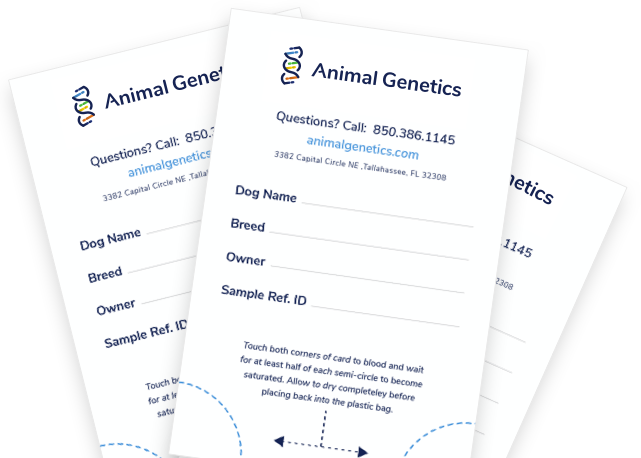

Feline sample collection is quick and simple if you follow a few basic guidelines. It is important to remember that the quality of the sample submitted to the lab is extremely important in the entire testing process so please be careful and follow the instructions below.
If you have any additional questions or require assistance please call Animal Genetics and speak to one of our customer service representatives, or visit our FAQ page where the answers to many common questions can be found.
For kittens under 6 weeks or not weaned we strongly recommend submitting either a small blood sample on our PermaCode card or a cotton swab (bud). For animals over 6 weeks and weaned we recommend any one of the three methods below. Please avoid placing samples in plastic bags or sealed containers unless the sample is completely dry.
Animal Genetics provides buccal (cheek) brush kits to our customers as a simple, non-invasive way to obtain DNA from your cat. Each sample collection kit contains 2 swabs and is good for multiple tests per cat. Please note that swabs should not be used on cats under under 6 weeks or not weaned.
To order buccal (cheek) brush please visit Feline Sample Collection Kits. Samples can also be obtained using interdental go-between brushes sold at most grocery stores, pharmacies, and major retail locations.
To collect samples for testing, follow the instructions below:
- Prior to sample collection, please make sure that the cat being tested has not eaten anything for at least 1 hour. Otherwise, the sample can be contaminated with food particles that can interfere or inhibit our reactions. Right before you take the sample, please visually check the cat’s mouth to ensure it is clean and clear of any possible contaminants.
- Label the envelope containing the sample collection brushes with the appropriate cat’s name and breed.
- Begin by removing 1 of the brushes from the envelope and placing it in the cheek of the cat and twist the brush between the cat’s cheek and gums for about 10-15 seconds. Repeat the same process with the second brush.
- Place both brushes back in the envelope and allow them to air dry for a few minutes before sealing the envelope. It is important not to send the brushes back in a plastic bag; moisture trapped within the bag could lead to bacterial growth on the swabs. This bacterial growth can degrade the DNA causing the sample to no longer be viable.
- Please print your submission form found on the My Orders page and submit with your sample.
- Remove the card from the plastic bag and fill out the information on the card including the animals name or ID.
- Cut the nail just short enough to cause a little blood to form on the end. Collect the drops of blood by touching the corners of the card to the end of the cut nail. Each corner of the card should be filled at least half way.
- Allow the blood to completely dry for 15-30 minutes before placing it back in the plastic bag. Wet samples sealed in the plastic bag will grow bacteria and damage sample quality.
- Only one blood sample is required per animal. Although not generally necessary, you may use a blood coagulant to stop the bleeding if it does not stop on its own.
- Please print your submission form found on the My Orders page and submit with your sample.

An easy and reliable sample for genetic testing is a small blood sample collected from the end of a clipped toenail and placed on a dry cotton swab (bud) or filter paper. Blood samples are strongly recommended for animals under under 6 weeks or not weaned.
To collect samples for testing, follow the instructions below:
- Cut the nail just enough to cause a little blood to form on the end.
- Collect 1-2 drops of blood by dabbing an ordinary cotton swab (bud), cotton pad or ordinary filter paper on the end of the cut nail.
- Allow the blood to completely dry for at least 15 minutes. Then place the swab into an standard PAPER envelope or PAPER bag. Wet samples in plastic bags will not allow the sample to dry properly and will grow bacteria. Label the sample with the animals name or ID.
- Only one blood sample is required for each animal. Although generally not necessary, you may use a blood coagulant to stop the bleeding.
- Please print your submission form found on the My Orders page and submit with your sample.